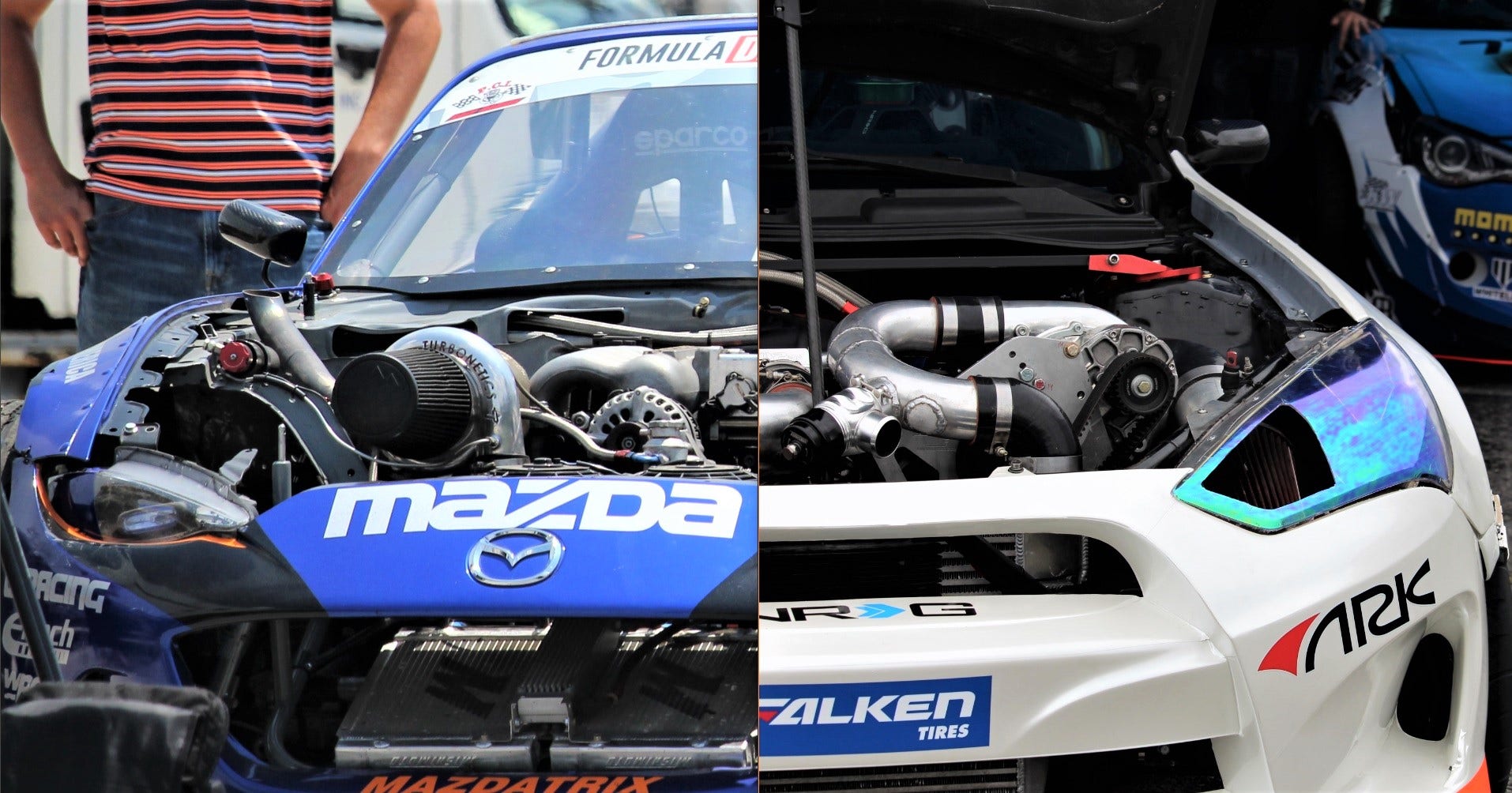
Forced Induction 101: Turbocharging vs. Supercharging
Competitive racing can be simplified. It boils down to a very basic question: Who's faster? Where it gets nuanced is when this idea branches off into other areas of competition based on driver preference and customization. We see this from competing companies as they choose different methods of business operations and seeing their way as more efficient. The same goes for popular discussion topics, people aligning themselves with what they find best represents who they are. In fact, my middle school time capsule included a representation of this competition by listing items and companies in the same category and who or what I'd choose over the other. Part of that capsule would have things like this in it:
- Cartoon Network or Nickelodeon
- Sprite or 7Up
- Breakfast or Dinner
- Vanilla or Chocolate
- Biggie or Tupac
- Seinfeld or Friends
- McDonalds or Burger King
So, we were supposed to dig that up in ten years and see how much our pre-teen opinions change. I haven't looked at mine since I made it, primarily because I have no clue where it's buried, but I know nothing would have changed. If you want to know my choices, they would all be named first in those comparisons. Nowadays, I'd like to believe my list of this versus that has matured. Now I think about things like:
- Android or iPhone
- NASCAR or Formula 1
- Winter or Summer
- Liquor or Beer
- Hulu or Netflix
- LS Motors or Literally Anything Else
- Buying Food or Car Parts
I generally side with the latter options (deal with it). Another thing I think about, though, is turbocharging or supercharging. The motor in my 1995 Nissan 240SX is still stock. When it comes to drifting, that motor does a fine job, (you just HAVE to go fast) but more power couldn't hurt. There are options out there for both methods of boost for my application, but I constantly think about which route I'd go if I were to add either an R or a T to my engine code (Nissan does that, other manufacturers have other specific designations).
For our next Technical Article segment, we are going to get into the bare basics of forced induction. First, let's quickly define the term boost. We all know engines create power by harnessing controlled explosions in their cylinders, and these explosions are caused by igniting a pre-calculated amount of compressed air and fuel. Naturally aspirated cars (often referred to as NA applications) rely on the vacuum of the piston to pull air into the cylinders, and the lowest point of the piston stroke is the maximum amount of air that can be drawn in - let's say in our theoretical engine, it's a liter. Boost happens when you force more than a liter of air into the same cylinder space, sometimes 50% more, sometimes 100% more; it all depends on the parts you use to accomplish this. Forcing more air into the cylinder means more fuel can be injected, creating a bigger explosion, and more power.
There are, however, two different ways cars can achieve this. One vents and the other whines.

This is arguably the most famous (and my favorite) example
Turbocharging
Let's first talk about a common form of boost known as turbocharging. Turbocharging has been around for quite some time. They were primarily used in planes during the first World War, but the automotive community caught wind of this and started applying turbochargers to engines in cars. So how do they work? Our beloved Jeremy Clarkson once said "Exhaust gases go into the turbocharger and spin it, witchcraft happens [audience laughter] and you go faster."
There isn't much witchcraft involved here, folks! The concept isn't difficult to grasp. Imagine a bonfire. If you blow on the smoldering embers, the result is more fire. The concept, although a bit primitive, is essentially the same for boost. With more air in the cylinder, there is more boom, which means more power.
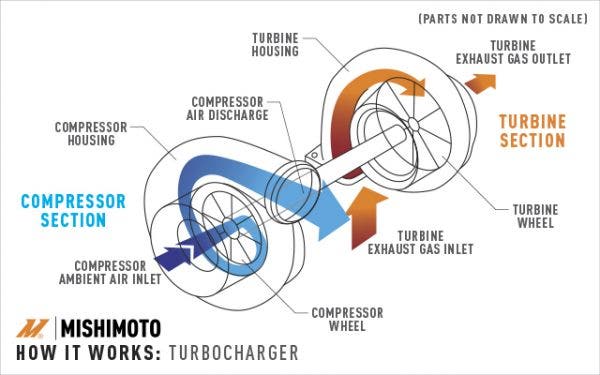
No Harry Potter hijinks going on here, just science!
Generally, the most visible part of a turbo is the compressor housing, which is the part that force feeds more air into the engine and is considered the cold side of the turbo. The hot side of the turbo, the turbine housing, is the side that spins a turbine from expelled exhaust gases. Remember, some vehicle applications can expel exhaust gases at temperatures of over 1000˚C, so these housings need to be heavy duty. To make this easier, imagine two fans on the ends of a shaft. If one side is spun by exhaust gases (the turbine wheel), the entire shaft spins, forcing the fan on the other end (the compressor wheel) to spin, thus creating an airstream that is directed back into your engine - we call that boost.

That is one big snail on Kyle Mohan's Formula Drift competition MX-5!
On most stock turbocharged applications, and those with aftermarket turbochargers, there is that famous and audible "pshhh" sound that comes from the engine when the throttle is abruptly closed. Again, not witchcraft! When the throttle is opened, a surge of air is forced into the cylinders; we know that. But, what happens when the throttle is then abruptly closed? This air has nowhere else to go but back into the compressor housing, which causes compressor surge, and that is bad. The part that prevents this from happening is called a bypass or diverter valve, or, in most circles, a blow-off valve (BOV). This valve can redirect incoming air back to the intake tract in front of the turbocharger, alleviating pressure buildup in the cold side of the system (from the turbocharger to the to the intake manifold), or vent that air to the atmosphere. The latter is where you hear the "pshhh" sound more pronouncedly. Although they are named differently, they all do the same thing. You can take a BOV and route it to the intake and vice versa. This is required for cars with a mass airflow sensor (MAF). Non-MAF based cars (referred to as speed density) have a little more wiggle room and can vent to the atmosphere (and just like that, I've thought of another idea for a technical article).

A blast from the past! Check out the engine bay of our old 1989 Nissan 240SX shop car!
In the photo above, we have an example (albeit, an extreme one) of a turbocharged application. In fact, the engine bay belongs to our old 1989 Nissan 240SX shop car, equipped with a fully built SR20DET engine. If you look towards the lower left-center of the engine, near the radiator, you'll see a big cylindrical shaped object; that is the BOV. The opening vents trapped air out of the system and into the atmosphere.
One major con to turbocharging is the system experiences what is called lag. Generally, turbochargers don't immediately build boost. You have to flow enough exhaust gas in order to spin the turbocharger fast enough to build that boost. Depending on the turbocharger size, this may require a high RPM. Before airflow is generated, you are not seeing the turbo work to its full capacity, which is the period of lag. Superchargers, on the other hand, can eliminate that lag, but come with a few caveats of their own.
Supercharging
Superchargers are, in theory, simpler to understand, because the system is less complex compared to turbocharging. While turbochargers are powered by exhaust gases, superchargers - or "blowers" to those in the drag racing world - are designed to work instantaneously. The primary difference between the two is how they are driven to produce power. Superchargers are mechanically driven by the engine's crank using a belt or a chain, instead of by exhaust gases. There are three types of superchargers: a twin screw, roots lobe, and centrifugal.
Roots and Twin-Screw
Roots style and twin screw superchargers are popular methods of forced induction in classic muscle car applications. They are similar in that they use counter-rotating compressor lobes to spin in conjunction with each other to move air, but there are differences between the two designs.
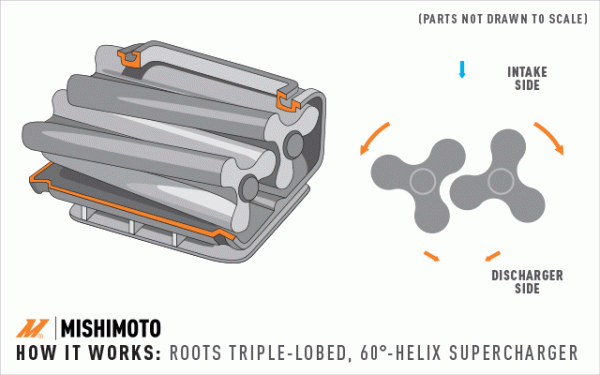
Roots style superchargers mount on top of the engine's intake manifold and contain two lobes that collect air from the device's intake side, direct that air around the lobes' outside casting, then discharge the air into the intake manifold. It's basically a giant air pump. These lobes can only spin in one direction, so they are good at flowing high amounts of air at low and high RPMs. Even when your RPMs are low, roots style designs can still create high and immediate amounts of boost. However, roots style designs emit a lot of heat and can deliver inefficient airflow. The actual air compression doesn't take place in the supercharger, it takes place inside of the manifold. All the lobes are doing is moving air at a faster rate than the piston draws. This airflow can be lumpy and in bursts, thus creating pockets of inefficiency.

Our very own member from the Marketing department snapped this pic of a high horsepower supercharged muscle car last year!
Twin screw (or Lysholm) superchargers are similar in theory, but different in the way they work. The lobes are shaped as large screws that interweave with each other when they spin and compress the air inside of the supercharger before it goes to the manifold. Since the lobes don't actually touch, like the roots style, these superchargers produce less heat. The tight tolerances between the screws means that these superchargers are more efficient at lower RPM. One minor disadvantage is that these superchargers are always compressing air while idling, decelerating, or cruising, so it must draw more power from the engine. These units are also fitted with an internal recirculation valve to redirect the compressed air back into the inlet of the device.

Here's a diagram of how a twin-screw style supercharger works

Roush supercharger for newer model Mustangs
Centrifugal
Centrifugal superchargers work similarly to turbochargers. At first glance, the two look a lot alike; however, in supercharger fashion, they are not exhaust-gas driven. Although these applications were founded on more updated technology compared to the designs above, it is commonly known as the first type of supercharger that was applied to automotive engines.

Cutaway of a centrifugal supercharger
With centrifugal superchargers, an internal impeller is what generates boost. As this impeller spins, air is brought in to the center and spun off the rims of the blades via centrifugal force, hence why we call them centrifugal superchargers. The housing of the supercharger starts off small, but gets progressively larger towards the discharge outlet, so the airflow has higher pressure when it leaves the device.

Diagram of how a centrifugal supercharger flows air
Centrifugal superchargers act like a high speed fan. Unlike roots or twin-screw superchargers, which have a fixed displacement, a centrifugal supercharger's displacement varies with RPM. This means that the supercharger is more effective over a larger RPM range, which then means the supercharger is more effective over a broader RPM range. It also emits much less heat thanks to its compression ratio and free wheel design. Fewer moving parts make these superchargers reliable; however, much like turbocharging, there is lag. While it is supplying extra air into the system at all times, it needs to be spun at high speeds to produce meaningful boost. Lubrication is also a slight downfall since they require oil to be drawn from the engine's oil pan. In order to run this type of supercharger, you'll need to tap your oil pan using feed and return lines.
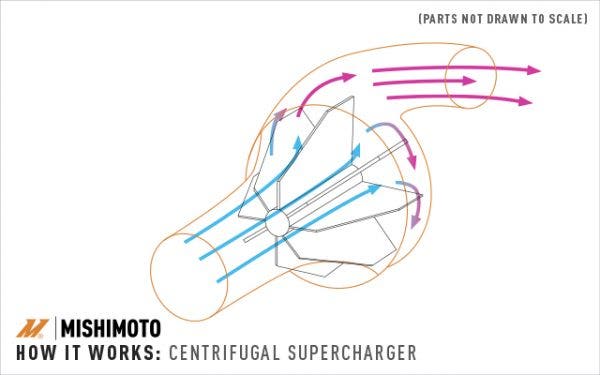
How airflow is drawn into a centrifugal type supercharger
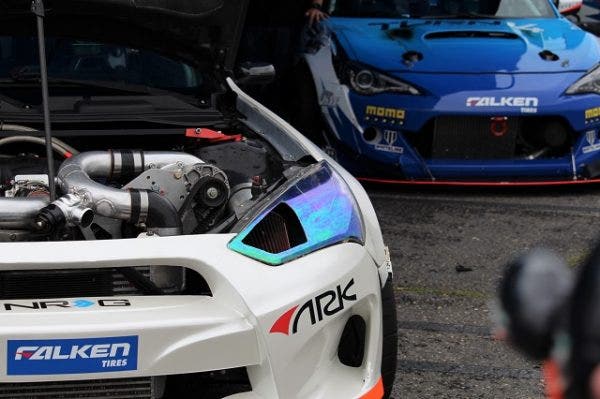
Formula Drift driver Aurimas "Odi" Bakchis has a centrifugal supercharger in his Hyundai Genesis!
All Things Considered
Time should be spent weighing the handful of options if you're choosing the route of forced induction. The more air force-fed into your motor, especially when the application came naturally aspirated from the factory, the more stress gets put on the engine. For example, with turbocharging, turbine housings generate a lot of heat, and this heat gets spread around the engine bay and we all know that an engine receiving hot air is a bad thing.
You need to be sure that the compressor housing is sending in cool air. In theory, you could simply connect the turbo housing outlet directly to the throttle body, but the car would run horribly because the engine is only getting very hot air. This is where a charge-air cooler comes into play, more commonly referred to as an intercooler. Compressed air is denser than uncompressed air, but as mentioned above, it brings in more heat, not including the increased ambient engine bay air temperatures that result from a turbo. An intercooler is a heat exchanger that cools the air from the turbo before it gets to the throttle body. Different sizes and different core constructions all affect how efficient the cooling can be, but I won't dive too deep into that. We have an in-depth article that explains every single aspect of intercoolers that you should take a look at.

A drift car prepping for an event, see the intercooler in the front?
You also need to tune your car for a turbocharger. Even if you are just upgrading turbos, the air delivery is going to be different, so for your engine to make the best use of this modification, there are some aspects that will need to be changed, such as fuel delivery, ignition, internals (depending on power) and just overall maintenance items like head gaskets. You'll need to find out if your motor in good health. Do you think it will handle boost well? Have you done a leak down or a compression test yet?
Let's take the motor in my car as an example. It's old and the engine compression has seen better days. If I were to slap a turbo kit on it today without doing any other preventative maintenance, I think it would probably last one or two drift events before it blows up. To ensure my engine doesn't become another statistic to an over-eager owner just wanting more power, I'd want to take the engine apart, fully rebuild it and upgrade things like pistons, rods and engine bearings. It would be nice to avoid having my 22-year old, 2.4L, 100,000-plus-miles motor spectacularly ejecting a rod from the side of the block. I've seen that happen - no picnic.

Forumla Drift Japan Andrew Gray's Toyota Chaser equipped with a high horsepower, turbocharged 2JZGTE. Look at the turbo peering behind the headlight!
The stress forced induction puts on your engine is not to be overlooked. It's the same way for superchargers. Since they are belt driven, they essentially must rob the engine of power for you to make a gain of power; consider that a drivetrain loss. When advertising bolt-on supercharger kits, companies generally make up for that loss as it is pre-determined in the net gain. In theory, if a supercharger kit added 50hp to your particular application and does its thing without needing a belt or chain to spin, net gains could be much higher. If we apply what we know about general drivetrain loss from manufacturer-advertised horsepower numbers at the crank, it could be assumed that the net gains from a 50hp-rated supercharger kit could be 30% to 40% higher without needing the engine's power to run.
That is all wild, unproven theory, but my point is this: before you consider forced induction on your naturally aspirated car, be sure that you have a healthy enough engine to handle it. Once you've done that, clean out your garage, grab a wrench, an oil rag and get to work.








